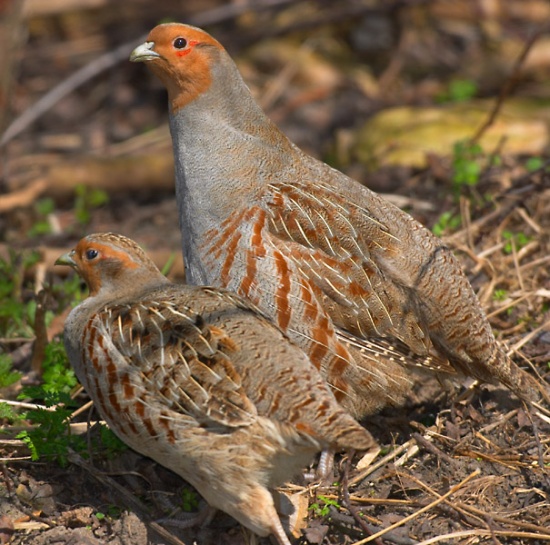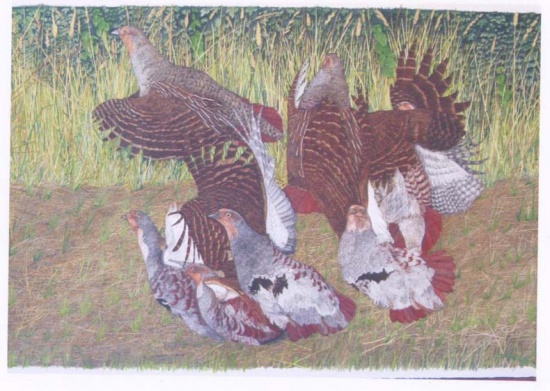BigRedBirder (talk | contribs) |
(→External Links: New Video search created) |
||
| (12 intermediate revisions by 4 users not shown) | |||
| Line 1: | Line 1: | ||
| − | + | [[Image:Grey_Partridge.jpg|thumb|550px|right|Photo by {{user|piotr+biegaj|piotr biegaj}}<br />Northern [[Poland]], April 2004]] | |
| − | [[Image:Grey_Partridge.jpg|thumb|550px|right|Photo by piotr biegaj]] | + | ;[[:Category:Perdix|Perdix]] perdix |
==Identification== | ==Identification== | ||
| − | *Relatively small headed and | + | *Relatively small headed and chubby |
*Orange face and throat | *Orange face and throat | ||
*Green bill | *Green bill | ||
| Line 11: | Line 11: | ||
====Female==== | ====Female==== | ||
Similar to male, but duller | Similar to male, but duller | ||
| + | ====Similar Species==== | ||
| + | [[Image:50712Picture 054.jpg|thumb|550px|right|Artwork by {{user|ARTHUR+BISHOP|ARTHUR BISHOP}}<br />Norfolk. U.K, 2006]] | ||
| + | [[Red-legged Partridge]] | ||
| + | ==Distribution== | ||
| + | Breeds throughout [[Europe]] from the [[UK]] to [[Kazakhstan]], and [[Scandinavia]], with a patchy distribution in southern [[Europe]]. | ||
| − | + | Also found in parts of southern [[Canada]] ([[Alberta]], [[Saskatchewan]] and [[Manitoba]]) and northern [[USA]], where it was introduced from Europe, as a game bird and has thrived on the prairies and agricultural land. | |
| + | ==Taxonomy== | ||
| + | ====Subspecies<sup>[[#References|[1]]]</sup>==== | ||
| + | There are 7 subspecies: | ||
| + | *''P. p. perdix'': | ||
| + | :*[[British Isles]] and southern [[Scandinavia]] to [[Alps]], [[Italy]] and [[Balkans]] | ||
| + | *''P. p. sphagnetorum'': | ||
| + | :*Moors of northern [[Holland]] and north-western [[Germany]] | ||
| + | *''P. p. armoricana'': | ||
| + | :*Locally in [[France]] | ||
| + | *''P. p. hispaniensis'': | ||
| + | :*Central Pyrénées (north-eastern [[Portugal]] and northern [[Spain]]) | ||
| + | *''P. p. lucida'': | ||
| + | :*[[Finland]] east to Ural Mountains and south to Black Sea and northern Caucasus | ||
| + | *''P. p. robusta'': | ||
| + | :*Ural Mountains to south-western [[Siberia]] and north-western [[China]] | ||
| + | *''P. p. canescens'': | ||
| + | :*[[Turkey]] east to the Caucasus, Transcaucasia and north-western [[Iran]] | ||
| − | |||
| − | |||
| − | |||
==Habitat== | ==Habitat== | ||
| − | + | Can be found on a wide variety of habitats, from farmland to moorland and sand dunes. | |
| − | Adults | + | Adults are more likely to be seen in open grass or vegetation the young, however, prefer cereal crops. |
| + | ====Status==== | ||
| + | Once common, the population has crashed, possibly due to farming practices. | ||
==Behaviour== | ==Behaviour== | ||
| + | Can be found in 'coveys' outside of the breeding season. | ||
| + | ====Action==== | ||
| + | They are inclined to fly close to the ground. Wing flaps produce a whirring noise. | ||
====Diet==== | ====Diet==== | ||
| − | Adults | + | Adults: grass, seeds and shoots; also insects when breeding.<br > |
| − | ==== | + | Chicks: only eat invertebrates such as sawflies, beetles and aphids. |
| − | + | ====Breeding==== | |
| − | == | + | Mid-April to early September. Up to 16 eggs laid in a well-hidden scrape nest lined with grass and leaves. If they lose their first clutch, they may lay again. |
| + | ====Vocalisation==== | ||
Includes a high, hoarse ''keev'', and a ''pitt-pitt-pitt'' when alarmed. | Includes a high, hoarse ''keev'', and a ''pitt-pitt-pitt'' when alarmed. | ||
| − | + | {{ Audio|Perdix perdix (song).mp3 }} | |
| − | |||
| − | |||
| − | |||
| − | + | ==References== | |
| − | + | #{{Ref-Clements6thAug14}}#ArKive | |
| − | + | #BF Member observations | |
| + | {{ref}} | ||
| + | ==External Links== | ||
| + | {{GSearch|"Perdix Perdix" {{!}} "Grey Partridge"}} | ||
| + | <br /> | ||
| + | {{VSearch|"Perdix Perdix" {{!}} "Grey Partridge"}} | ||
| + | {{GS-checked}}1 | ||
| + | <br /> | ||
| + | <br /> | ||
| − | + | [[Category:Birds]] [[Category:Perdix]][[Category:Bird Songs]] [[Category:Videos]] | |
| − | |||
| − | [[Category:Birds]] | ||
Latest revision as of 22:37, 25 February 2023
- Perdix perdix
Identification
- Relatively small headed and chubby
- Orange face and throat
- Green bill
- Grey legs
Male
- White underbelly
- Chestnut horseshoe on lower breast
Female
Similar to male, but duller
Similar Species
Distribution
Breeds throughout Europe from the UK to Kazakhstan, and Scandinavia, with a patchy distribution in southern Europe.
Also found in parts of southern Canada (Alberta, Saskatchewan and Manitoba) and northern USA, where it was introduced from Europe, as a game bird and has thrived on the prairies and agricultural land.
Taxonomy
Subspecies[1]
There are 7 subspecies:
- P. p. perdix:
- British Isles and southern Scandinavia to Alps, Italy and Balkans
- P. p. sphagnetorum:
- P. p. armoricana:
- Locally in France
- P. p. hispaniensis:
- P. p. lucida:
- Finland east to Ural Mountains and south to Black Sea and northern Caucasus
- P. p. robusta:
- P. p. canescens:
Habitat
Can be found on a wide variety of habitats, from farmland to moorland and sand dunes. Adults are more likely to be seen in open grass or vegetation the young, however, prefer cereal crops.
Status
Once common, the population has crashed, possibly due to farming practices.
Behaviour
Can be found in 'coveys' outside of the breeding season.
Action
They are inclined to fly close to the ground. Wing flaps produce a whirring noise.
Diet
Adults: grass, seeds and shoots; also insects when breeding.
Chicks: only eat invertebrates such as sawflies, beetles and aphids.
Breeding
Mid-April to early September. Up to 16 eggs laid in a well-hidden scrape nest lined with grass and leaves. If they lose their first clutch, they may lay again.
Vocalisation
Includes a high, hoarse keev, and a pitt-pitt-pitt when alarmed.
References
- Clements, J. F., T. S. Schulenberg, M. J. Iliff, D. Roberson, T. A. Fredericks, B. L. Sullivan, and C. L. Wood. 2014. The eBird/Clements checklist of birds of the world: Version 6.9., with updates to August 2014. Downloaded from http://www.birds.cornell.edu/clementschecklist/download/
- ArKive
- BF Member observations
Recommended Citation
- BirdForum Opus contributors. (2024) Grey Partridge. In: BirdForum, the forum for wild birds and birding. Retrieved 30 April 2024 from https://www.birdforum.net/opus/Grey_Partridge
External Links
GSearch checked for 2020 platform.1





